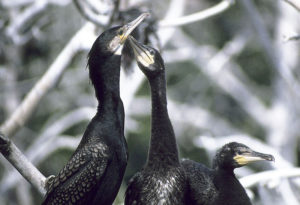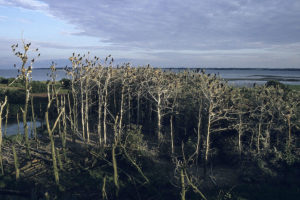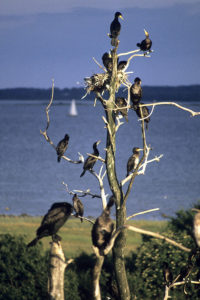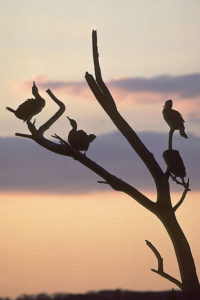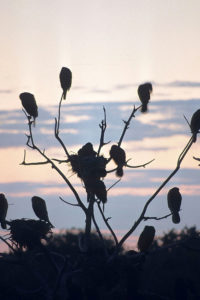Kaj Halberg - writer & photographer
Travels ‐ Landscapes ‐ Wildlife ‐ People
Night in the cormorant city

On all sides, the hide is surrounded by naked grey poplars (Populus x canescens), filled with cormorant nests, in which parents are very busy feeding their gluttonous young. Towards evening, the cormorants, which already have fledged young, together with immature, non-breeding birds, return to the colony to spend the night here. There is a lot of quarrel and squabbling to get the best positions to sleep, as the place is cramped, when 3,000 birds are going to sleep in the remaining trees of the plantation. The birds peck at their neighbour with their sharp bill, causing him or her to retreat to a poorer sitting place – or to peck back.
Naturally, young birds get the worst places. In this place, the strongest birds are ruling. Many young from this year have fallen out of the nest, before they were able to fly, and they must spend the night on toppled tree trunks in the pond – a very risky place, as the fox (Vulpes vulpes) has a litter, which has to be fed, and later taught the art of killing. From an elder scrub, a fox rushes into the pond, takes hold of the wing of a young, dragging it towards the shore. A tremendous turmoil erupts in the entire colony. The young cormorant screams in despair, but is too inexperienced to use its only weapon – the bill. On the shore, a quick bite ends its struggling.
Finally, the cormorants calm down and settle down to sleep. A strange, vibrating, growling gaaar from some bird or other can be heard now and then. Otherwise, everything is quiet. A Full Moon slowly rises over the fiord, casting a cold light on the sleeping city. I creep down into my sleeping bag, but cannot fall asleep. Time and again I must get up to see it all once again – the Moon, the dead trees, the sleeping birds.
At dawn, I’m on my feet again – or rather, on my knees, as this cramped hide is too low for me to stand erect. The cormorants are still asleep, standing out as silhouettes against a faintly pink sky. Slowly, the cormorant city awakes. One by one, the birds alight, heading out to feed.
